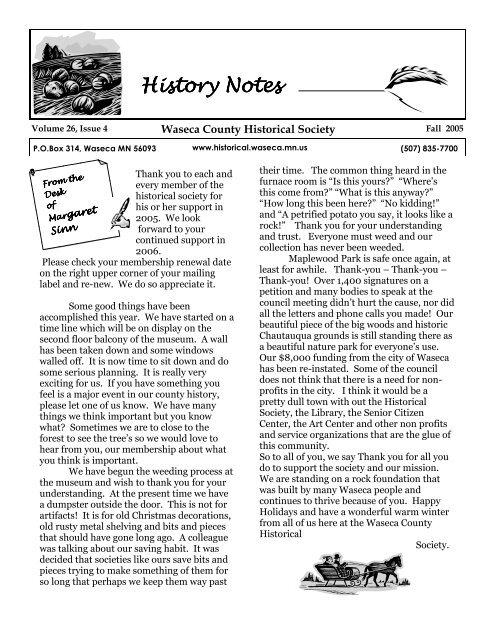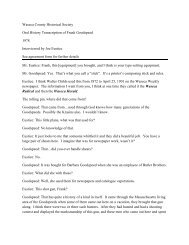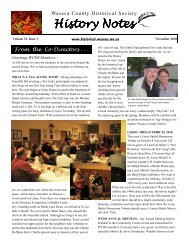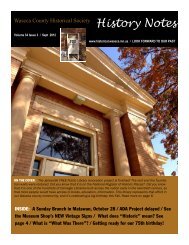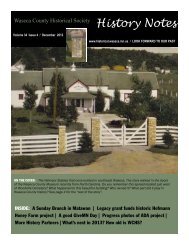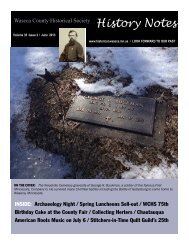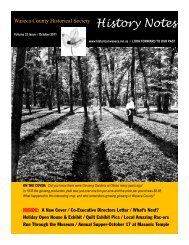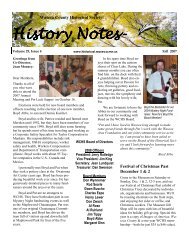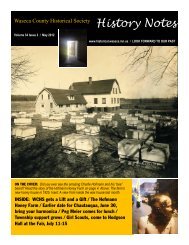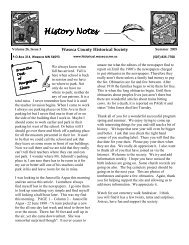Fall - Waseca County Historical Society
Fall - Waseca County Historical Society
Fall - Waseca County Historical Society
Create successful ePaper yourself
Turn your PDF publications into a flip-book with our unique Google optimized e-Paper software.
History Notes<br />
Volume 26, Issue 4<br />
<strong>Waseca</strong> <strong>County</strong> <strong>Historical</strong> <strong>Society</strong><br />
<strong>Fall</strong> 2005<br />
P.O.Box 314, <strong>Waseca</strong> MN 56093<br />
www.historical.waseca.mn.us<br />
(507) 835-7700<br />
Thank you to each and<br />
every member of the<br />
historical society for<br />
his or her support in<br />
2005. We look<br />
forward to your<br />
continued support in<br />
2006.<br />
Please check your membership renewal date<br />
on the right upper corner of your mailing<br />
label and re-new. We do so appreciate it.<br />
From the<br />
Desk<br />
of<br />
Margaret<br />
Sinn<br />
Mar<br />
Some good things have been<br />
accomplished this year. We have started on a<br />
time line which will be on display on the<br />
second floor balcony of the museum. A wall<br />
has been taken down and some windows<br />
walled off. It is now time to sit down and do<br />
some serious planning. It is really very<br />
exciting for us. If you have something you<br />
feel is a major event in our county history,<br />
please let one of us know. We have many<br />
things we think important but you know<br />
what? Sometimes we are to close to the<br />
forest to see the tree’s so we would love to<br />
hear from you, our membership about what<br />
you think is important.<br />
We have begun the weeding process at<br />
the museum and wish to thank you for your<br />
understanding. At the present time we have<br />
a dumpster outside the door. This is not for<br />
artifacts! It is for old Christmas decorations,<br />
old rusty metal shelving and bits and pieces<br />
that should have gone long ago. A colleague<br />
was talking about our saving habit. It was<br />
decided that societies like ours save bits and<br />
pieces trying to make something of them for<br />
so long that perhaps we keep them way past<br />
their time. The common thing heard in the<br />
furnace room is “Is this yours?” “Where’s<br />
this come from?” “What is this anyway?”<br />
“How long this been here?” “No kidding!”<br />
and “A petrified potato you say, it looks like a<br />
rock!” Thank you for your understanding<br />
and trust. Everyone must weed and our<br />
collection has never been weeded.<br />
Maplewood Park is safe once again, at<br />
least for awhile. Thank-you – Thank-you –<br />
Thank-you! Over 1,400 signatures on a<br />
petition and many bodies to speak at the<br />
council meeting didn’t hurt the cause, nor did<br />
all the letters and phone calls you made! Our<br />
beautiful piece of the big woods and historic<br />
Chautauqua grounds is still standing there as<br />
a beautiful nature park for everyone’s use.<br />
Our $8,000 funding from the city of <strong>Waseca</strong><br />
has been re-instated. Some of the council<br />
does not think that there is a need for nonprofits<br />
in the city. I think it would be a<br />
pretty dull town with out the <strong>Historical</strong><br />
<strong>Society</strong>, the Library, the Senior Citizen<br />
Center, the Art Center and other non profits<br />
and service organizations that are the glue of<br />
this community.<br />
So to all of you, we say Thank you for all you<br />
do to support the society and our mission.<br />
We are standing on a rock foundation that<br />
was built by many <strong>Waseca</strong> people and<br />
continues to thrive because of you. Happy<br />
Holidays and have a wonderful warm winter<br />
from all of us here at the <strong>Waseca</strong> <strong>County</strong><br />
<strong>Historical</strong><br />
<strong>Society</strong>.
Peg Mawby’s<br />
Sinter Klaus’<br />
of the Past<br />
A very special show<br />
will be exhibited<br />
through December<br />
2005 at the WCHS Museum. We are pleased to<br />
present the work of Peg Mawby. Over the years<br />
Peg has created hundreds of Sinter Klaus figures.<br />
Each one is unique and adorned with antique fabric<br />
and trimmings. Peg is retiring and will not be<br />
having her annual Sinter Klaus Holiday sale.<br />
evolve, changing size as<br />
larger figures or very little<br />
figures,<br />
always striving for that<br />
old European look.<br />
Peg retired from her annual<br />
Sinter Klaus sales last<br />
November 2004. So now<br />
they are all in private<br />
collections. Some of the<br />
best are from local<br />
residents and here at<br />
<strong>Waseca</strong> <strong>Historical</strong> <strong>Society</strong> Museum for the month<br />
of<br />
December.<br />
Who is<br />
SINTER KLAUS?<br />
BY JAMES FAIRHURST<br />
ABOUT PEG MAWBY<br />
The Sinter Klaus figures in this exhibit were all<br />
created by Peg Mawby. Peg has lived in <strong>Waseca</strong><br />
since 1987 when she opened Oma’s Antiques. She<br />
has loved the antique business all her life. She<br />
began making things with the many vintage fabrics<br />
and materials she found in her continuous search<br />
for wonderful antiques. Her first creations were<br />
actually fashion dolls that she made in the early<br />
1980s. But she soon moved on to designing her<br />
own patterns and the fashion dolls evolved into the<br />
Sinter Klaus figures. Each one she makes is<br />
unique, inspired by yet another piece of vintage<br />
fabric or sack cloth, or piece of fur, leather, a<br />
Christmas ornament, or antique child’s toy. She<br />
never knew what the next inspiration would be, but<br />
was always excited with an array of those vintage<br />
or antique materials around her as she would start<br />
making her figures to be sold in November every<br />
year. And every year the Sinter Klaus would<br />
Sinter Klaus is the Dutch<br />
name given Father<br />
Christmas, and the source of<br />
the derived Americanized—<br />
Santa Claus. Until the<br />
beginning of the 19th<br />
century, Father Christmas or<br />
Sinter Klaus was pictured as<br />
a tall, thin stately man who<br />
wore a bishop’s robe and<br />
rode a white horse. He had a long beard and carried<br />
various gifts for the children.<br />
In 1809, Washington Irving, the creator of Rip Van<br />
Winkle, published Knickerbockers History of New<br />
York in which St. Nicholas was described as a<br />
stout, jolly man who wore a broad brimmed hat,<br />
huge breeches and smoked a long pipe. Irving's St.<br />
Nicholas rode over tree tops in a wagon and filled<br />
children's stockings with presents. Clement Clarke<br />
Moore ( 1779 - 1863) added to the picture in a<br />
ballad written for his children which is now well<br />
known and begins, “Twas the night before<br />
Christmas”.<br />
Moore was a Hebrew scholar and Professor of<br />
Greek and Oriental Literature at New York's
General Theological<br />
seminary from 1821 to<br />
1850. He is said to have<br />
composed “A Visit from St.<br />
Nicholas” to amuse his<br />
children at Christmas. In<br />
1822 and, unknown to him,<br />
a house guest copied it and<br />
gave it to the press. The<br />
poem was first published<br />
anonymously in the New<br />
York Sentinel on December 23, 1823. In Moore's<br />
poem, St. Nicholas appears as a stout, jolly man<br />
with twinkling eyes and a red nose, riding a sledge<br />
pulled by eight reindeer. Thomas Nast, an<br />
American cartoonist, completed the present day<br />
image of Father Christmas in a series of drawings<br />
for Harpers Weekly Magazine between 1863 and<br />
1886.The drawings show Santa Claus with a white<br />
beard, working in his shop, driving a sleigh led by<br />
reindeer and placing Christmas presents in<br />
stockings over a fireplace.<br />
Earlier in Holland, Father Christmas’ name had<br />
become Sinter Klaus, and when Dutch settlers<br />
arrived in the New World and founded New<br />
Amsterdam (later renamed New York), they took<br />
their Sinter Klaus customs with them and named<br />
their first church after him. The Americanized<br />
pronunciation of Sinter Klaus became Santa Claus<br />
and this became established as his name. By the<br />
1870s, this benign figure had arrived in Britain and<br />
was quickly merged with Father Christmas.<br />
Although today people in many parts of the<br />
world are familiar with Santa Claus, he is primarily<br />
an American invention. In the past Santa Claus had<br />
dressed in a whole range of different colors,<br />
wearing a long cloak and heavy boots. Clement<br />
Moore had described him as being “dressed all in<br />
fur from his head to his foot and his clothes were<br />
all tarnished with ashes and soot”.<br />
All this was to change in the 1930s with a Coca<br />
Cola promotion in which Haddon Sundbloom<br />
redesigned Santa Claus. His colors now were<br />
specially chosen to match the trade colors of Coca<br />
Cola being red and white. A thigh-long red tunic<br />
with white trimmings was held in place by a broad<br />
black belt. On his head was a floppy nightcap, red<br />
with white trim and a white pom-pom, and to<br />
complete the picture his red trousers were tucked<br />
into a pair of heavy black boots. From that time on,<br />
the western world's Santa followed Sundbloom's<br />
design and is now firmly established in the hearts<br />
and minds of people everywhere.<br />
Coming down the chimney is a curious way to<br />
enter a house and Moore's poem is the direct<br />
source. He wrote “And there on a twinkling I heard<br />
on the roof, The prancing and pawing of each little<br />
hoof, As I drew in my head and was turning around<br />
Down the chimney St. Nicholas came with a<br />
bound.”<br />
Moore was a scholar well versed in<br />
anthropology and had researched the ancient myths<br />
and legends of Christmas before writing his poem.<br />
He knew that the Lapland dwellings were small,<br />
igloo-shaped tents covered with reindeer skins and<br />
sunk into the ground with the entrance being a hole<br />
in the roof to allow the smoke from the fire to<br />
escape. In the poem, when Santa Claus arrives, his<br />
reindeer can be heard on the roof which covers the<br />
Lapp's abode. He enters with a single bound in the<br />
manner of someone leaping down the chimney.<br />
Before Moore's poem, Father Christmas either<br />
walked or rode a white horse. Moore would also<br />
know of a Finnish legend concerning Old Man<br />
Winter. The belief was that with winter's onset this<br />
mythical creature would drive his reindeer down<br />
from the mountains bringing snow with him. There<br />
is a link here with reality for the fierce mountain<br />
winter would drive the reindeer down into the<br />
plains to seek shelter. Moore incorporated this into<br />
his ballad, naming the eight<br />
reindeer. The number eight was<br />
chosen because Odin, a Teutonic<br />
god, rode an eight-legged horse.<br />
Once the poem was published and<br />
became immensely popular, Santa<br />
Claus's transport would, forever<br />
after, be a sleigh pulled by eight<br />
reindeer. Moore's romantic image<br />
will doubtless last for as long as Christmas is<br />
celebrated.
Whispering Tombstones<br />
A Historic Cemetery Walk . . .<br />
was held Friday, October 28, 2005 at Woodville<br />
Cemetery. Guests were escorted by horse drawn<br />
wagon from the east end of the cemetery to the<br />
beginning of the walking tour. Each group was<br />
led through the darkness by a non-speaking guide<br />
dressed as a faceless spirit. The guides by the<br />
light of a single lantern moved the groups to and<br />
from each tombstone where they were greeted by<br />
a historic <strong>Waseca</strong> character.<br />
The first stop was the resting place of Miss<br />
Mattie Murphy. Mattie was born Martha Inez<br />
Murphy on November 2, 1872. The very proud<br />
parents were John Fisk Murphy and Emma Jane<br />
Hiller Murphy. John Fisk Murphy was a printer<br />
who relocated to <strong>Waseca</strong> from Wilton to work<br />
with James Childs on the<br />
newspaper. Mattie was<br />
well photographed in her<br />
early years. She was a<br />
darling child and a<br />
beautiful young woman.<br />
Many portraits are in the<br />
WCHS Collection. We<br />
became interested in Mattie<br />
when we came across her<br />
diary of sorts while<br />
processing scrapbooks for<br />
the collection. She had<br />
taken an old book and used<br />
the pages like a scrapbook,<br />
cutting and pasting illustrations, articles, poetry—<br />
anything that interested her. Mattie was an artist.<br />
She studied art in Minneapolis and was known for<br />
her posters and artwork used to advertise<br />
community and church events in <strong>Waseca</strong>. Mattie<br />
is photographed with friends at the T.B.<br />
Sanatorium on Lake Pokegama in Pine <strong>County</strong>.<br />
Her diary contains correspondence that refers to<br />
her health, but it is not clear if she was a patient<br />
or working at the hospital. Mattie never married.<br />
It has been said her parents were against a<br />
relationship Martha was in and consequently it<br />
ended. Mattie was an extremely religious person.<br />
She was devoted to God and the Church.<br />
Mattie could be seen in her later years walking<br />
downtown. It is said she would spend much of her<br />
time at Stucky’s drugstore, just hanging around<br />
reading and watching people come<br />
and go. Mattie died in 1955 penniless.<br />
She may have given all she<br />
had to the church, although no<br />
record of this has been found.<br />
Mattie seemed to be ahead of her<br />
time. She stands out as a unique<br />
individual who lived in a world<br />
known only to her. Sadly, no stone<br />
marks the grave of Mattie or her<br />
mother. Only the flat small stone of<br />
John Murphy marks the final<br />
resting place of this family. Mattie<br />
has no surviving relatives in<br />
<strong>Waseca</strong> <strong>County</strong>. Mattie Murphy<br />
was played by our own<br />
Teri Pribble.<br />
Our second featured citizen Mr. Philo C. Bailey<br />
played by WCIS teacher Michael Koranda.<br />
P. C. Bailey was an early merchant who moved his<br />
hardware store from Wilton to<br />
<strong>Waseca</strong> in 1867. He was also a<br />
State Senator as well as a<br />
member of the Common<br />
Council of <strong>Waseca</strong> and was a<br />
<strong>Waseca</strong> <strong>County</strong> Commissioner<br />
from 1895-1897. He took a<br />
prominent and useful part in the<br />
construction of the courthouse<br />
in 1897. He married Lurinda<br />
Dodge in 1867. They lived at 400 N.E. Wood<br />
Avenue, which is now called 2nd Avenue and<br />
houses the research facility for WCHS genealogy<br />
library.<br />
His only surviving relative we found was very<br />
helpful during the house renovation.<br />
Continuing on in the tour we came upon the<br />
grave of Captain Rinehart Miller played by<br />
Scott Roemhildt. Captain Miller was one of the<br />
first men to enlist for the defense of the Union in<br />
1861. He was a member of Company E, and served<br />
in the Army of the Potomac. He was wounded in<br />
the cavalry fight at Buckland Mills VA. in 1863<br />
(Continued on page 5)
and taken prisoner at Trevillion<br />
Station VA on June 11, 1864.<br />
He was one of the few men to<br />
survive the infamous<br />
“Andersonville Camp” for<br />
prisoners of war in<br />
Andersonville, Georgia. In<br />
February 1872, Capt. Miller<br />
came to <strong>Waseca</strong> with his wife<br />
Julia, and eight children. He<br />
owned and operated a general store for 27 years.<br />
One of the daughters, Nettie, became Mrs. E.A.<br />
Everett and another, Bessie, Mrs. E. W. Ward, and<br />
son John married Daisy Aughenbaugh. Nettie<br />
Miller was tragically killed while on a train in<br />
Mexico in 1909. She was 41 years old. The train<br />
was hit from behind as it idled on the tracks. She<br />
was in the observation car, the last on the train.<br />
In 1916 daughter Gene married brother-in-law E.A.<br />
Everett. She took over raising 14 year-old<br />
Constance and maintaining the home in <strong>Waseca</strong>. In<br />
1909 Rinehart and Julia moved to Minneapolis, as<br />
did son Hugo and wife Edith. Julia died on July 21,<br />
1919. Rinehart died on March 17, 1927 from<br />
bronchial pneumonia. He was 83 years old.<br />
Captain Miller organized Company A of the<br />
National Guard and served as captain and drill<br />
master of the company. Captain Rinehart Miller<br />
has no remaining relatives in <strong>Waseca</strong> <strong>County</strong>.<br />
Next on the tour was the Trowbridge/Ward<br />
monument. Ira Trowbridge, played by Out-To-<br />
Lunch”owner Rick Roberts, was the founder of<br />
<strong>Waseca</strong>. He was instrumental in bringing the<br />
railroad to <strong>Waseca</strong> and<br />
developing the town. He came<br />
from Illinois in 1866 and<br />
purchased the land that <strong>Waseca</strong><br />
sits upon from a farmer named<br />
Jacob K. Meyers. James Child<br />
sums up Ira as . . . “a man of<br />
nerve and iron will and allowed<br />
no man to thwart his plans<br />
without suffering for his<br />
temerity sooner or later.”<br />
Trowbridge’s first enterprise<br />
was a hotel for the influx of people arriving in<br />
<strong>Waseca</strong>. Mrs. Judith Trowbridge was known to be<br />
a gracious and kind hostess, although suffering<br />
from bad health. Mr. Trowbridge was assisted by<br />
W. G. Ward and J. H. Jenkins in the early years of<br />
<strong>Waseca</strong>. Later both men would become sons-inlaw.<br />
W. G. Ward married Trowbridge’s youngest<br />
daughter, Ella in 1867. J. H. Jenkins married<br />
Augusta Trowbridge in 1867. Son Adolphus died<br />
in 1873. Son Edgar C. engaged in the hardware<br />
business in this city. The Trowbridge once faced<br />
State Street, but was turned to face the park named<br />
for him in the 1920s. It now belongs to the Pribble<br />
family. Ira Trowbridge died suddenly of heart<br />
failure October 3, 1893. No<br />
living relatives reside in<br />
<strong>Waseca</strong>.<br />
Sharing the plot with the<br />
Trowbridges is the family of<br />
W. G. Ward, played by<br />
WCHS Board Member<br />
Dennis Kuefner. Ward<br />
married Ella after coming to<br />
<strong>Waseca</strong> in 1867. Ward was<br />
Chief Engineer in the construction of the Winona<br />
and St. Peter Railroad.<br />
Ward invested in property in and around <strong>Waseca</strong>.<br />
He built a home that stands on Second Avenue<br />
N.E. across Curator’s from the WCHS Corner Museum. Ward had<br />
two children, By Pauline Clarence Fenelon and and Anne Teri with Pribble his first wife<br />
Martha Dodge. Martha died in 1865. With Ella<br />
they had four children: Martha, Roscoe Percy,<br />
Florence and Earl. W. G.Ward died in September<br />
1892 after a long illness. He was remembered as a<br />
friend of the poor and a kind, well loved and<br />
missed member of the<br />
community.<br />
The next stop on the tour was<br />
the Everett family mauseleum.<br />
Welcoming the vistors was Lilly<br />
Everett Curtiss, played by our<br />
own Sheila Morris. The beautiful<br />
marble mausoleum is nearly<br />
surrounded by the 17 family<br />
graves. Lilly Everett was the<br />
daughter of William Everett by<br />
his first wife Almira Hatch. Almira and her two<br />
small sons were killed in the Sioux Indian attack at<br />
(Continued on page 6)
(Continued from page 5)<br />
Lake Shetek in 1862. Details of this event can be<br />
found in the Child’s History of <strong>Waseca</strong> <strong>County</strong>.<br />
William Everett was wounded and left for dead.<br />
Lilly was six years old when she witnessed the<br />
killing of her mother, brothers and other women<br />
and children living in the settlement. She was taken<br />
captive by the Sioux. Mr. Everett escaped with<br />
other wounded survivors to a nearby farm. Months<br />
later Lilly was set free and was reunited with her<br />
father at Fort Dodge, Iowa.<br />
William remarried Amelia Addison in 1865 and<br />
with Lilly moved to <strong>Waseca</strong> in 1867 where<br />
William opened a general store. William and<br />
Amelia had a son in 1868, Edward. “E. A.” as he<br />
would be known developed the mill business with<br />
his father’s partner, John Aughenbaugh, to form<br />
the EACO Flour Mill on the shore of Loon Lake.<br />
Lilly married Dan Curtiss and<br />
never had any children. She<br />
died in 1923.<br />
The last stop on the tour<br />
was the final resting place<br />
of Grace Cooper played by<br />
Marlene Rietfort.<br />
Grace was the most recent<br />
person on the tour. Grace<br />
died in 1974 after leaving<br />
<strong>Waseca</strong> and moving to<br />
Marshall, Minnesota. Many in <strong>Waseca</strong> knew and<br />
remember her. She was known for her crusade<br />
against the evils of alcohol. She was an active<br />
member of the <strong>Waseca</strong> Women’s Christian<br />
Temperance Union. Grace spear-headed the annual<br />
Tuberculosis Christmas Seals sales, and was<br />
credited for the establishment and expansion of the<br />
<strong>Waseca</strong> Library. She is remembered fondly by Dr.<br />
Rethwill as a family friend. Grace and Harold<br />
Cooper rest eternally beside the Rethwill family<br />
plot.<br />
Many thanks to the following volunteers<br />
for the production of Whispering Tombstones,<br />
A Cemetery Walk!<br />
ACTORS: Teri Pribble, Michael Koranda,<br />
Scott Roemhildt, Dennis Kuefner, Rick Roberts,<br />
Sheila Morris, and Marlene Rietfort.<br />
NON-SPEAKING ACTORS: Tom and Bobbie<br />
Holtz<br />
GUIDES: Sheryl Wilder, Karen Simmons, Rita<br />
Miller, Lori Weller, Vanessa Zimprich and Jake<br />
Sachs.<br />
SINGERS: Amy Roemhildt, her mom and son,<br />
Cody<br />
WAGON MASTERS: Mert Schwarz, Joleen<br />
Gunderman and her nephew, Harlan Gekelerfor<br />
the use of his wagon.<br />
PRODUCTION ASSISTANCE: Andrew Breck<br />
COSTUMES: Suzy Kuefner<br />
WOODVILLE CEMETERY BOARD: Pastor<br />
Roger Haug, Dr. Wes Rethwill and Robert<br />
Neigebauer<br />
LANTERNS & LIGHTS: Andrew Breck, Mert<br />
Schwarz, Ron Purcell, Holtz’s, Karen Simmons<br />
GREETERS: Lanae Feser and Janet Welch<br />
What’s Happening at WCHS<br />
The WCHS Annual Meeting was held Tuesday,<br />
October 25, 2005 from 6:00-7:30 p.m. A<br />
delicious Pot Luck Dinner was served. Special<br />
Guest, photographer Doug Ohman, presented slides<br />
from his new book, Minnesota<br />
Churches. This book as well as<br />
Doug’s previous book, Barns of<br />
Minnesota, is available at the<br />
WCHS giftshop. Thirteen images<br />
of <strong>Waseca</strong> <strong>County</strong> barns are<br />
featured in this wonderful book.<br />
Some signed copies remain.<br />
Both books sell for $19.95.<br />
Festival of Wreaths and Sinter Klaus’ of the Past<br />
will be on display as long as our lenders let us<br />
keep them—December! Come and see them! The<br />
sooner the better!<br />
The Museum Giftshop has been restocked for the<br />
holidays—check out our many ornaments and<br />
decorations for gift-giving. We’re open 8-5, Mon-<br />
Fri—that’s noon hours, too! Coming in February—<br />
A Photo Exhibit, “Preservation Alliance of<br />
Minnesota’s Ten Most Endangered Buildings.” The<br />
featured buildings are from all around the state,<br />
selected for their historical significance and<br />
architectural interest.
LEFT: Lilly (Sheila Morris) and P.C.Bailey played by<br />
Michael Koranda.<br />
BELOW: Amy Roemhildt and her mom, and son Cody.<br />
Sheila Morris, as Lilly Everett Curtiss<br />
ABOVE: Lanae Feser,<br />
greeter<br />
ABOVE: Teri Pribble as Mattie Murphy<br />
BELOW: Dennis Kuefner as W.G.Ward<br />
makes a point.<br />
ABOVE: Scott Roemhildt as<br />
Captain Rinehart Miller.<br />
ABOVE: Karen Simmons, a<br />
“confused guide”<br />
RIGHT: Tom Holtz is <strong>Waseca</strong><br />
journalist, James Child.<br />
Photos by Pauline Fenolyn
WASECA COUNTY<br />
HISTORICAL SOCIETY<br />
P.O. BOX 314<br />
WASECA MN. 56093<br />
NON-PROFIT<br />
U.S. POSTAGE PD.<br />
WASECA MN.56093<br />
PERMIT # 41<br />
CHANGE SERVICE REQUESTED<br />
Membership renewal date<br />
Memorials<br />
Nettie Krause, Shirley Woyke, Emmeth Swenson, Ethel Sotabeer, Troy Roemhildt, Lydia Bahr,<br />
F.H. Deef.<br />
New Members and Renewals<br />
Jean McCarthy, George McCarthy, Marge Ross, Lois Gleason, Paul Carpenter, Michael D. Lacopo,<br />
Terry Mohring, Larry Johnson, Diane Wendland, George Parola, Tina Frye, Rodney Hatle, Janet Welch, Patricia<br />
Millard, Les Tlougan, Deb Dobberstein, Selma Reb, Susan Eckert, Anne Sandbeck, Alan Doyle, Barb Herme, Barb<br />
Noble, Melissa Peterson, Jody Johnson, Pat Mortenson, Lyle Olson, Leta Clemons, Bonnie Born, Pat Helyer, Ann<br />
Berrie, Ardella Draheim, Barbara Kopischke, Janine Burr, Marjorie Gores, Margie Arndt, Neil and Sharon Fruechte,<br />
Joe and Marge Britton, Vida Ahlman, Benjamin Imker, Mary Warfield, Sandy Thalmann, William Sudduth, Mike and<br />
Jean Halvorson, Vicki Baird, Janet Sabraski, Bill Burns, Leo Fette, Kristi Steele, Thomas Holman, Pamela Gehring,<br />
John Brassfield, Gail Stanley, Tracy Frederick, Suzanne Mackey, Jayne Staley, Public Library of Cincinnati, Leona<br />
Benson Michael Hecht, Margaret Hasslen, Diane DonCarlos.<br />
Life Members<br />
Bumps Brown, Emmeth Swenson, Betty Sheeran,<br />
Gladys Brynildson, Dorothy Moriarty, Gus Cooper, Liz Corchran


